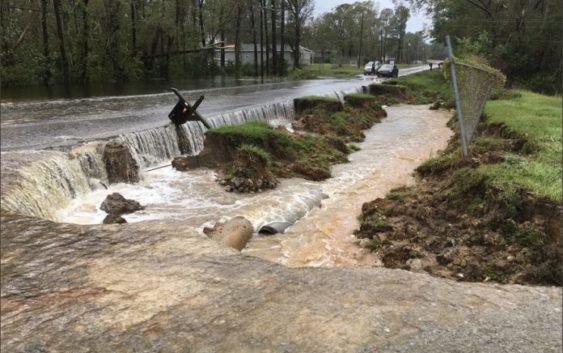- Seven months after Hurricane Helene, Chimney Rock rebuilds with resilience
- Wildfire in New Jersey Pine Barrens expected to grow before it’s contained, officials say
- Storm damage forces recovery efforts in Lancaster, Chester counties
- Evacuation orders lifted as fast-moving New Jersey wildfire burns
- Heartbreak for NC resident as wildfire reduces lifetime home to ashes
Alliance of Southeastern NC mayors and commissioners requesting funding from legislature to prevent flooding

WILMINGTON, NC (WWAY) — The Eastern NC Recovery and Resilience Alliance leadership shared six legislative priorities on Thursday for the NC General Assembly to consider as it allocates funding and shapes policy to help the region better prepare for, respond to, and recover from flood events.
- Fund an actionable Flood Resilience Blueprint
- Ensure resilient critical transportation infrastructure
- Support riverine and stream management to reduce flooding
- Incorporate resilience investments as an allowable use into any new local revenue authority
- Increase resiliency capacity and technical assistance to local governments
- Fund flood mitigation and innovative pilot projects
In recent years, flooding from hurricanes, 1000-year storms, tidal flooding, and intense non-tropical storms have caused widespread damage to eastern NC communities. These events revealed the region’s vulnerability to more frequent and severe floods demonstrate the need to build more resilient communities.
“Hurricane Florence was nearly the straw that broke the camel’s back,” said Wilmington Mayor Bill Saffo. “That hurricane was the exclamation point at the end of a long series of damaging flood events that compelled elected officials from the eastern part of the state to come together in search of solutions. Our communities had been struggling to recover from damaging floods and challenged to build back in a way that made us less vulnerable to facing the same threats again the next time a storm or heavy rains rolled through. Through our work together, we’ve found pathways to recovery and resilience, and now we need the funding to implement the next steps we’ve identified.”
Will McDow, Environmental Defense Fund Resilient Landscapes Director, explained the need for science and data that would come from the blueprint so that communities can create solutions and decision-makers at local, state, and federal levels can provide funding and other necessary support.
“They need this data and modeling to ensure that public investments are going to work, that taxpayer dollars are going to be spent wisely, and that resident’s lives and livelihoods will be protected,” McDow said.
Reflecting on several major roads being impacted by flooding during Hurricane Florence, Saffo said the southeastern part of North Carolina is the fastest growing area in the state and with the rapid growth and growing population, we can’t be cut off from the rest of the country when a major hurricane hits.
“We’ve got to do something to improve the resiliency in these communities or else we’re going to continue to deal with this issue over and over and over and spend a tremendous amount of taxpayer dollars fixing the same thing over and over again,” Saffo said.
The alliance is made up of elected officials from the eastern part of the state who have come together to develop collaborative solutions as their communities recover from recent major flooding events and strengthen their resilience to future floods. Officials with the Alliance have been meeting over the past two years and working with national experts at the American Flood Coalition and Environmental Defense Fund to identify policy and funding opportunities to create a more resilient eastern North Carolina.
These priorities have been shared with representatives at the state and federal level, Saffo says the response so far has been great and they will continue having the important discussions that will lead to more assistance for the region.